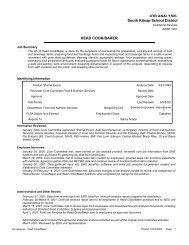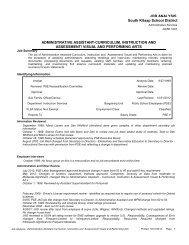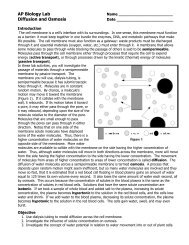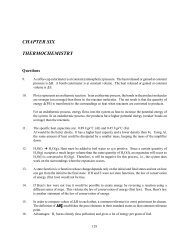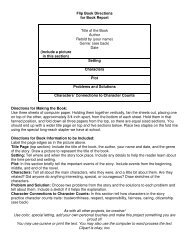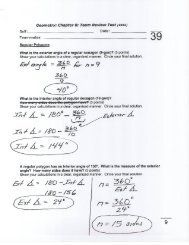Using Punnett Squares to Predict the Outcomes of Crosses /20
Using Punnett Squares to Predict the Outcomes of Crosses /20
Using Punnett Squares to Predict the Outcomes of Crosses /20
You also want an ePaper? Increase the reach of your titles
YUMPU automatically turns print PDFs into web optimized ePapers that Google loves.
Integrated Science II<br />
Ch. 7 Explain<br />
G g<br />
g Gg gg<br />
g Gg gg<br />
Name __________________________<br />
Period _______ Date _____________<br />
<strong>Using</strong> <strong>Punnett</strong> <strong>Squares</strong> <strong>to</strong> <strong>Predict</strong> <strong>the</strong> <strong>Outcomes</strong> <strong>of</strong> <strong>Crosses</strong> /<strong>20</strong><br />
The possible gene combinations in <strong>the</strong> <strong>of</strong>fspring that result from a genetic cross can be determined by drawing a<br />
diagram known as a <strong>Punnett</strong> square. A <strong>Punnett</strong> square shows <strong>the</strong> genes (represented by letters) in <strong>the</strong> parents’<br />
gametes along <strong>the</strong> <strong>to</strong>p and left-hand side <strong>of</strong> a square and <strong>the</strong> possible gene combinations <strong>of</strong> <strong>the</strong> <strong>of</strong>fspring, within <strong>the</strong><br />
square. A completed <strong>Punnett</strong> square gives <strong>the</strong> probable outcome <strong>of</strong> a given cross. However, actual results may vary<br />
from <strong>the</strong> probably results, especially if only a few organisms are considered.<br />
ONE-FACTOR CROSSES<br />
<strong>Crosses</strong> that involve one trait, such as seed coat color, are called one-fac<strong>to</strong>r crosses. For <strong>the</strong> one-fac<strong>to</strong>r crosses in this<br />
activity we will use some <strong>of</strong> <strong>the</strong> traits Mendel observed in pea plants. The expressions <strong>of</strong> <strong>the</strong> dominant and recessive<br />
alleles for <strong>the</strong> genes controlling <strong>the</strong>re traits are described in <strong>the</strong> following chart. The chart also assigns letters <strong>to</strong><br />
represent <strong>the</strong> different alleles.<br />
Trait Dominant Allele Recessive Allele<br />
Pod shape Smooth (N) Constricted (n)<br />
Pod color Green (G) Yellow (g)<br />
Flower position Axial (A) Terminal (a)<br />
Plant height Tall (T) Short (t)<br />
Sample Problem<br />
In this example, we will predict <strong>the</strong> results <strong>of</strong> a cross between a plant that is heterozygous for green pods and a plant<br />
that has yellow pods. What are <strong>the</strong> probable genotypic and phenotypic ratios in <strong>the</strong> <strong>of</strong>fspring resulting from this cross?<br />
Step 1 – Choose a letter <strong>to</strong> represent <strong>the</strong> alleles in <strong>the</strong> cross.<br />
In this case, <strong>the</strong> letters have already been selected, G for <strong>the</strong> dominant green allele and g for <strong>the</strong> recessive<br />
yellow allele.<br />
Step 2 – Write <strong>the</strong> genotypes <strong>of</strong> <strong>the</strong> parents.<br />
Since <strong>the</strong> plant with <strong>the</strong> green pods is heterozygous for <strong>the</strong> trait, its genotype must be Gg. The problem does<br />
not state whe<strong>the</strong>r <strong>the</strong> plant with yellow pods is homozygous or heterozygous. But we know that yellow pods are<br />
a recessive character, and that recessive characters are expressed only in a homozygous recessive individual.<br />
Step 3 – Determine <strong>the</strong> possible gametes (reproductive cells) that <strong>the</strong> parents can produce.<br />
The two alleles <strong>of</strong> any gene are segregated during <strong>the</strong> formation <strong>of</strong> gametes. Thus <strong>the</strong> green-pod parent (Gg)<br />
will produce two kinds <strong>of</strong> gametes—G and g. The yellow-pod parent (gg) will produce g gametes.<br />
Step 4 – Enter <strong>the</strong> possible gametes at <strong>the</strong> <strong>to</strong>p and side <strong>of</strong> <strong>the</strong> <strong>Punnett</strong> square.<br />
At this point, <strong>the</strong> <strong>Punnett</strong> square for this problem would look like this:<br />
Step 5 – Complete <strong>the</strong> <strong>Punnett</strong> square by writing <strong>the</strong> alleles from<br />
<strong>the</strong> gametes in <strong>the</strong> appropriate boxes.<br />
This step represents <strong>the</strong> process <strong>of</strong> fertilization, in which a male gamete from one parent combines with a<br />
female gamete from <strong>the</strong> o<strong>the</strong>r parent. To predict all possible <strong>of</strong>fspring genotypes, each type <strong>of</strong> possible gamete<br />
from one parent is combined with each possible type <strong>of</strong> gamete from <strong>the</strong> o<strong>the</strong>r parent.<br />
As you can see, half <strong>of</strong> <strong>the</strong> <strong>of</strong>fspring are genotype Gg<br />
and half are gg.<br />
Step 6 – Determine <strong>the</strong> phenotypes <strong>of</strong> <strong>the</strong> <strong>of</strong>fspring.<br />
Since green (G) is dominant over yellow (g), plants that have G in <strong>the</strong>ir genotypes have green pods. Only plants<br />
with genotype gg have yellow pods. Half <strong>of</strong> <strong>the</strong> <strong>of</strong>fspring have green pods and half have yellow pods.<br />
Step 7 – <strong>Using</strong> <strong>the</strong> results <strong>of</strong> Steps 5 and 6, answer <strong>the</strong> problem.<br />
In this example, <strong>the</strong> genotypic ratio is 0 GG : 2 Gg : 2 gg, or 0:1:1. The phenotypic ratio is 2 green:2 yellow, or 1:1.<br />
g<br />
g<br />
G<br />
g
Practice problems<br />
For each <strong>of</strong> <strong>the</strong> following problems, draw a <strong>Punnett</strong> square in <strong>the</strong> space provided and fill in <strong>the</strong> information on <strong>the</strong><br />
indicated lines. Follow <strong>the</strong> steps on <strong>the</strong> front page.<br />
1. Nn × NN 2. Aa × aa<br />
Genotypic ratio: ________________________<br />
Phenotypic ratio: _______________________<br />
Genotypic ratio: ________________________<br />
Phenotypic ratio: _______________________<br />
3. Tt × Tt 4. Cross 2 plants that are<br />
heterozygous for green<br />
pods.<br />
Genotypic ratio: ________________________<br />
Phenotypic ratio: _______________________<br />
Genotypic ratio: ________________________<br />
Phenotypic ratio: _______________________<br />
5. Cross a plant that is<br />
heterozygous for axial<br />
flowers with a plant that<br />
has terminal flowers.<br />
6. Cross a homozygous tall<br />
plant with a short plant.<br />
Genotypic ratio: ________________________<br />
Phenotypic ratio: _______________________<br />
Genotypic ratio: ________________________<br />
Phenotypic ratio: _______________________<br />
7. Cross a plant that is<br />
heterozygous for smooth<br />
pods with a plant that<br />
has constricted pods.<br />
8. When a tall plant is crossed with a short plant,<br />
some <strong>of</strong> <strong>the</strong> <strong>of</strong>fspring are short. What are <strong>the</strong><br />
genotypes <strong>of</strong> <strong>the</strong> parents? What are <strong>the</strong> genotypic<br />
and phenotypic ratios <strong>of</strong> <strong>the</strong> <strong>of</strong>fspring?<br />
Genotypic ratio: ________________________<br />
Phenotypic ratio: _______________________<br />
Parent Genotypes: ___________ X ___________<br />
Genotypic ratio: ________________________<br />
Phenotypic ratio: _______________________<br />
9. Three-fourths (¾) <strong>of</strong> <strong>the</strong> plants produced by a<br />
cross between two unknown pea plants have axial<br />
flowers and one-fourth (¼) have terminal flowers.<br />
What are <strong>the</strong> genotypes <strong>of</strong> <strong>the</strong> parent plants?<br />
Parent Genotypes: ___________ X ___________<br />
10. What are <strong>the</strong> genotypes <strong>of</strong> <strong>the</strong> parents <strong>of</strong> a cross<br />
would result in ½ <strong>of</strong> <strong>the</strong> <strong>of</strong>fspring having green<br />
pods and ½ <strong>of</strong> <strong>the</strong> <strong>of</strong>fspring having yellow pods?<br />
Parent Genotypes: ___________ X ___________







